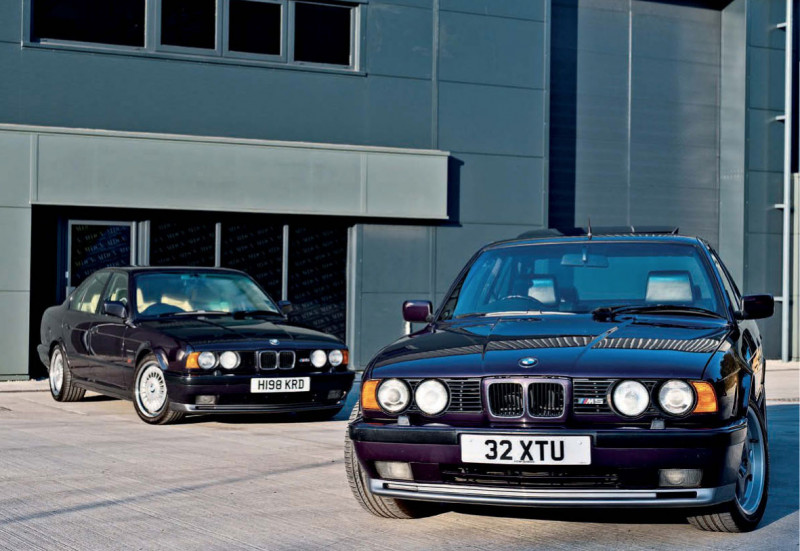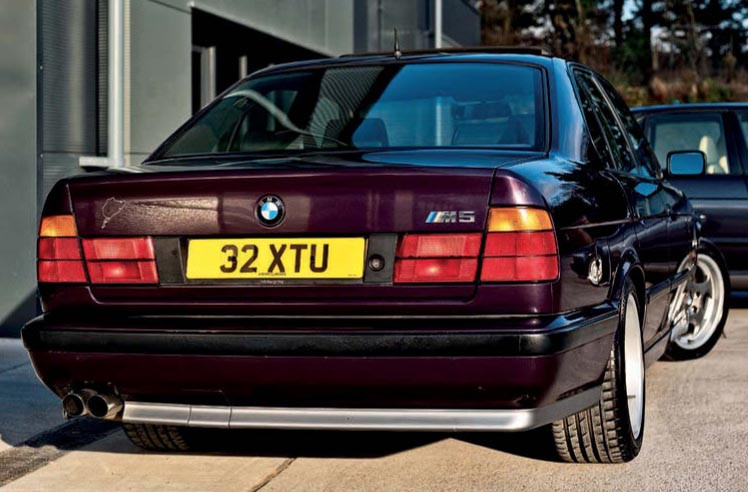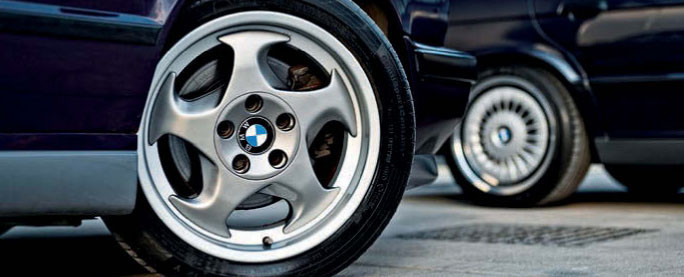Most iconic BMW 5 Series M5 - E34 3.6 vs. 3.8
Debate will rage over which is the best of the super saloon dynasty but the E34 must be a standout candidate in both 3.6- and 3.8-litre guises. Words: Bob Harper Photography: Jason Dodd
E34 M5 The most iconic 5 Series from BMW M? We compare 3.6 and 3.8 versions...
There’s a famous quote about opinions that I won’t elaborate on here for fear of lowering the tone but when it comes to the question of who has made the world’s greatest super saloons over the last 40-years or so there should be only one answer – BMW. And the model? It has to be the M5. Try to whittle the six generations down to one winner though and you have a far tougher job. Each generation has its fierce proponents and while I’m not going to definitively state that the E34 was the best it was certainly a sublime machine and had few, if any peers, when it was new.

“I went from owning no M5s to having two rare E34s in the space of just a few days!”

It was the first BMW M car to feature adaptive suspension – known as Electronic Damper Control when it made its debut on the 3.8-litre M5 – something that’s now a standard feature across the M car range. It was also the last of the hand-built M5s where painted shells were plucked from the Dingolfing production line and then sent to M’s HQ at Garching where the mechanical components and interiors were fitted. The E34 M5 was also the home for the largest capacity straight-six ever used by BMW and was also the first M car to utilize a coil-per-cylinder configuration on the later 3.8-litre versions. All in all it was quite a machine.

The E34 was the second-generation of M5, the first having been based on the E28 platform. The original M5 was a pretty limited run machine – just over 2000 were built of which over 1300 went to North America – but it was universally loved by everyone who drove it. Given its critical success it was inevitable that a second-generation model would be launched once the E34 5 Series made its debut. Despite a huge change in the styling the E28 and E34 utilised broadly similar building blocks so the job for M’s engineers was to refine the M5 concept for the E34 body.

Production commenced in the latter part of 1988 and at the heart of the M5 was a heavily revised version of the venerable M88 straight-six that could trace its roots back to the 24-valve CSL race cars and subsequently the M1 and E28 M5. For its E34 application it took on the twin duplex timing chain of US-spec E28 M5 models and while it shared the older unit’s 93.4mm bore its stroke was increased by 2mm for an 82cc capacity increase. This new unit was designated S38B36 and along with the upped capacity came a new forged steel crankshaft, a higher compression ratio, revised cams and Bosch Motronic injection which meant it was now good for 315hp at 6900rpm and 266lb ft of torque at 4750rpm.

This was mated to a five-speed manual Getrag gearbox and a 25 percent locking limited-slip differential and a revised version of the E34’s MacPherson strut and semi-trailing arm suspension. The M5 sat 20mm lower than a standard E34 with 25 percent stiffer springs, revised dampers and a self-levelling set up at the rear known as SLS. Steering was recirculating ball with a reduced ratio compared to the standard E34 and Servotronic speed-sensitive assistance was an option.
Externally the M5 was a picture of discretion with a subtle aero kit that closely aped that of the E34 Sport models but with the sills, lower front spoiler and rear bumper extensions painted in a contrasting colour to the rest of the body. There were no trademark M quad tailpipes at this stage and in the UK there were no M mirrors either – remove the small M5 badges and the M5 could simply be a well-spec’d 5 Series. The wheels were a bit of a giveaway though – 17-inch items (known as M System 1) with detachable centres known as ‘turbine vanes’ which were designed to suck cooling air onto the brakes as the wheels turned.

The M5’s interior was similar to a high-spec example of the standard car with sports seats trimmed in a mix of Motorsport cloth and Ameratta or leather with full leather as an option and some models had a storage compartment in the middle of the rear seats making them strictly four-seaters. Other M embellishments included red needles in the dashpod and the dropping of the economy swingometer in favour of an oil temperature gauge.
As a package the M5 was superb, offering a sonorous yet lusty straight-six, vivid performance (0-62mph took 6.4-seconds) and a brilliant duality of purpose – it was equally at home pottering to the shops, blitzing the autobahns or clipping apices. However, some elements of the press initially weren’t quite so enamoured with the M5 – it was almost as if its launch would provide a foretaste of what would happen when the E36 M3 replaced the E30. The bottom line was that it was hugely expensive – nigh on £45k before options – and this was at a time where the entry-level 5 Series, the 518i, could be had for £16,500. And while the M5 was a brilliant piece of kit, it was perhaps a little bit too polished, too sophisticated when compared to the older E28 version. Road testers seemed to rue the loss of the raw edges of the E28, with Car magazine saying it was “massively competent but not really fun to drive.” This was, of course, poppycock, and Autocar & Motor nailed it when it said; “This is a car without peer… The simple reality is that this is the most accomplished saloon car ever made. And don’t think for a moment it’s not good fun.”

BMW must have been stung by some of the slightly unflattering words that were written about the 3.6 though as in 1991 there was a heavily revised M5 unveiled at the Frankfurt show. Capacity was up to 3795cc thanks to an increase in both bore and stroke and there were new valves, lighter pistons, revised intake and exhaust manifolds along with Bosch Motronic 3.3 with distributor-less ignition with a coil per cylinder. Power was now up to 340hp at 6900rpm with torque swelling to 295lb ft at 4750rpm. A whole second was slashed from its 0-62mph time.
While the improved performance was most welcome it was changes to the car’s suspension set up that worked particularly well. Out went the 3.6’s traditional dampers and SLS rear end to be replaced by Electronic Damper Control (EDC) which used sensors to judge road speed, steering angle, acceleration and deceleration loads and lateral body movements to electronically choose the most appropriate damper rates. It was excellent, giving a supple ride when cruising yet tautening the set up when on a charge.
The last of the E34 M5s arrived in mid-1994 when the wider grille of late E34s was adopted along with a six-speed manual ‘box, upgraded brakes and 18-inch wheels. By August 1995 the E34 era was over and we’d have to wait until 1999 for the next generation of M5 to hit the streets in the UK. In total just 12,253 E34 M5s were made – 8344 3.6s and 3909 3.8s.
While other M cars have seemingly rocketed in price over the last decade or so the E34 M5 has dragged its heels but it seems as if it’s finally being appreciated for the truly wonderful machine that it is. Good examples are hard to come by, the two examples we have here both have low mileages and are owned by Tahmid Haque and his father Kiron. They’ve amassed quite a collection of fine BMWs (you can follow their car collection exploits on Instagram via ‘@m635bmw’ and it took quite a while for Tahmid to track down an E34 M5 for his collection… and he’s ended up with two, a Macau Blue 3.6 and a Daytona Violet 3.8.
The story behind their purchase is a little convoluted but Tahmid had been keeping an eye out for a good M5 to add to the collection for some time, keen to have an example of the last of the hand-built M cars in his stable. “I received a message on Instagram from a guy in Scotland asking for some advice about the best way to go about selling his BMW,” says Tahmid, “and after asking for some details about the car he told me it was a 3.6-litre M5 in Macau Blue with a Champagne interior. I was hooked. Unfortunately we couldn’t come to an agreement on a price so we left it that the car would remain in storage and that perhaps I’d change my mind as he wasn’t in a hurry to sell it. We kept in touch but still couldn’t come to a figure we both agreed on so I carried on my search for an M5. Eventually I found one of the last of the M5s, a 3.8 LE in Orinoco Green with Mint interior and with no agreement in sight for the 3.6 I decided to go for it. So, there I was basking in the glory of having added an M5 to the collection when the owner of the 3.6 got back in touch saying he was prepared to further negotiate on the price…”
To cut a long story short, Tahmid ended up doing the deal on the 3.6 as he felt like it was an unrepeatable car. He’s hugely keen on Macau Blue and combined with that was the fact that the 3.6 had several desirable options and just 57k miles on it. “We headed to Scotland to collect the car and it was everything I hoped it would be. The shutters rose on the storage facility and there it was – a simply stunning Macau Blue M5. After a thorough check over the deal was done and we hit the road for the 10-hour journey home. It was the first time the car had been driven any distance in four- or five-years and it was faultless, hugging the road nicely no matter what speed you were doing. I went from owning no M5s to having two rare E34s in the space of just a few days!”
The Daytona 3.8 is a more recent addition to the fold, the LE having been sold a while after the 3.6 arrived. Once again, it was the 3.8’s history and low mileage that attracted Tahmid to it and he believes it to be the only right-hand drive 3.8 in this colour combination.
The original invoice was still with the car and indicated that its list price in 1993 was £51,450 but with a host of options that was bumped up to £59,780 when it was first registered. Those with eagle eyes/photographic memories might recognise it was the example used in BMW Car back in 2012 when we did a five generations of M5 test with the then new F10.
But which one does Tahmid like best? “While most people seem to prefer the 3.8 I’m going to go out on a limb and say that it’s the 3.6 that I find the more engaging car to drive. I think that there could be quite a difference between the individual cars – the engines were hand built after all – and this one just feels really strong. It did have an engine rebuild around five- or six-years ago which might account for it, but it feels really free-revving and is an absolute delight to drive. To be brutally honest I find the E34 535i a better day-to-day car – the M5s do need to be driven hard and taken to the top of the rev range to get the best from them which can make them hard work. Ultimately they’re still brilliant, but I find the 535i more accessible,” comments Tahmid.
Either way, Tahmid is a lucky man indeed, especially as he has some E39 M5s in his collection too – he really is spoilt for choice when it comes to choosing which car to drive. The E34 M5 might have been eclipsed when it comes to performance but for a time it certainly was one of the greatest super saloons on the planet. Performance Car crowned the M5 as its Car of the Year in 1992 and it was a fitting final resting place for one of the world’s greatest straight-six engines. Long-time readers will know I’ve owned two of these fi ne beasts, doing 60,000-miles in the first of them over a three-year period. Perhaps I’m remembering it through rose-tinted glasses, but it really was an amazing machine and I might even have to stick my neck out and say it really was the ultimate M5.
I might have to stick my neck out and say it really was the ultimate M5...
E34 M5 3.6 3.8
- Engine: S38 straight-six, DOHC, 24-valve / S38 straight-six, DOHC, 24-valve
- Capacity: 3535cc 3795cc
- Max power: 315hp @ 6900rpm / 340hp @ 6900rpm
- Max torque: 266lb ft @ 4750rpm 295lb ft 4750rpm
- 0-62mph: 6.4-seconds / 5.4-seconds
- Top speed: 155mph (limited) / 155mph (limited)
- Number made: 8344 3909
- Price new: £43,465 (1990) / £55,000 (1995)
- In 1991 there was a heavily revised M5 unveiled at the Frankfurt show

